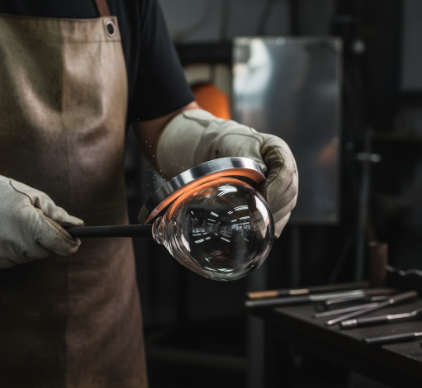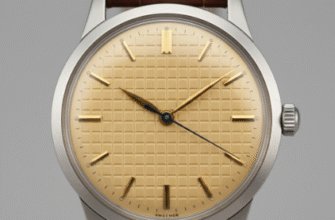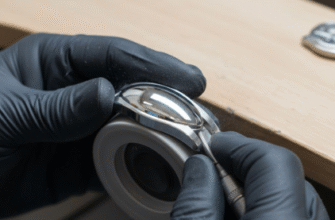The gentle curve of a domed crystal possesses a unique charm, a vintage warmth that flat, modern sapphire simply cannot replicate. Whether gracing the face of a timepiece or serving as the protective window for a delicate instrument, the dome invites light and interaction in a way that is both functional and deeply aesthetic. Yet, within this elegant curve lies a profound technical challenge: visual distortion. As the eye moves from the center to the periphery, the world seen through the glass can begin to bend, warp, and swim. Creating a dome that minimizes this effect is not merely manufacturing; it is a masterful blend of optical science and artisanal dedication.
At its heart, the problem is one of physics. Light, upon entering a new medium like crystal, changes speed and bends. This phenomenon, known as refraction, is the very principle that allows lenses to focus light. A simple domed crystal, with its constant spherical curvature, acts as a powerful, wide lens. Near the center, where the surface is almost flat relative to the viewer’s eye, light passes through with minimal deviation. But toward the edges, the angle of the curve becomes more extreme. Light entering from this steep angle is bent far more dramatically, causing the familiar pincushion or barrel distortion that makes straight lines appear to curve and dials seem to compress or stretch.
The Foundation: Material and Geometry
The journey to a distortion-free dome begins long before the first grind. It starts with the choice of material. The three most common materials in watchmaking and high-end optics are acrylic (often called Hesalite), mineral glass, and synthetic sapphire. Each has a different refractive index, which is a measure of how much it bends light. Acrylic has a low refractive index, making it inherently less prone to distortion, but it scratches easily. Sapphire, on the other hand, is exceptionally hard and scratch-resistant but possesses a very high refractive index, magnifying the challenge of distortion exponentially. The craftsman must therefore work with the inherent properties of the chosen material, not against them.
Beyond the material, the specific geometry of the dome is paramount. A simple, single-radius dome is the most common but also the most susceptible to peripheral distortion. To combat this, artisans have developed more complex profiles. The most sophisticated of these is the
aspheric dome. Unlike a spherical dome, which is a slice of a perfect sphere, an aspheric dome has a radius of curvature that subtly changes from the center to the edge. This complex, non-spherical profile is precisely calculated to correct for the aberrations that cause distortion, ensuring light rays are focused more accurately, regardless of where they pass through the crystal.
The Grind: Shaping Light Itself
The actual shaping of the crystal is where true mastery is displayed. The process begins with a raw, cylindrical block of material, often called a ‘blank.’ This blank is then subjected to a multi-stage grinding process. Initially, coarse diamond-impregnated tools are used to rough out the basic domed shape. In the modern era, this is often guided by computer numerical control (CNC) machines that can cut complex aspheric profiles with incredible precision.
The tolerances required in this stage are microscopic. For a high-quality optical dome, the surface profile must be accurate to within a few micrometers, or millionths of a meter. Any deviation from the ideal mathematical curve will introduce unwanted optical errors. This precision is often verified using laser interferometry, a technique that uses light wave patterns to detect surface imperfections far too small for the human eye to see.
However, technology alone is not the answer. The finest domes often involve a human touch. After the initial machine grinding, the crystal moves to a process called lapping. Here, the artisan presses the crystal against a spinning, precisely shaped tool coated with a succession of ever-finer abrasive slurries. This requires immense skill and feel. The craftsman must apply perfectly even pressure, constantly rotating the crystal to ensure a uniform and symmetrical curve. It is a slow, iterative process of removing material micron by micron, gradually smoothing the rough-ground surface into a perfect, translucent form.
The Soul of the Craft: Polishing to Perfection
If grinding gives the crystal its shape, polishing gives it its soul. A ground crystal is still opaque, its surface covered in microscopic pits and scratches. The goal of polishing is to smooth these imperfections away until the surface is optically perfect, allowing light to pass through without scattering or diffusing. This is arguably the most demanding phase of the entire process.
Using a soft pad made of pitch or specialized polyurethane, the artisan applies a series of diamond pastes, with particles decreasing in size from several microns down to a fraction of a micron. The choice of polishing pad, the consistency of the paste, the speed of the machine, and the pressure applied by hand all interact in a complex dance. Too much pressure can deform the delicate curve; too little will fail to remove the final vestiges of haze. It’s a meditative, sensory craft where the artisan learns to read the feedback from the material through their fingertips. The final stages can take hours of patient work to bring a single crystal to a state of flawless transparency.
Finishing Touches: The Unseen Perfection
Even after a perfect polish, the work is not done. To achieve the absolute pinnacle of clarity, the crystal undergoes a final enhancement: the application of an
anti-reflective (AR) coating. This coating is a microscopically thin layer, often composed of multiple layers of metallic oxides, vacuum-deposited onto the crystal’s surface. Its purpose is to cancel out light waves that would otherwise reflect off the surface, allowing more light to pass through. By reducing reflections and glare, an AR coating—especially on the underside of the dome—dramatically improves legibility and reduces the perception of any residual distortion. It makes the crystal seem to disappear, offering an unimpeded view of what lies beneath.
The creation of a optically pure domed crystal is a testament to the enduring value of craftsmanship. It is a field where cutting-edge optical science, precision engineering, and the irreplaceable sensitivity of the human hand converge. Each finished piece is not merely a transparent shield, but a carefully sculpted lens, designed and executed with the singular goal of bending light to its will, providing a view of perfect, undistorted clarity right to the very edge.









